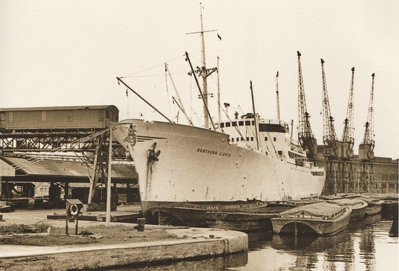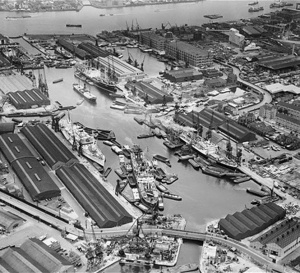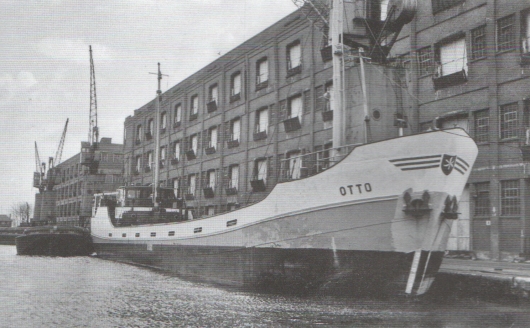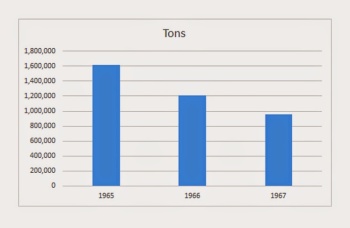♦♦♦♦♦♦♦♦♦♦♦♦♦♦♦♦♦♦♦♦♦♦♦♦♦♦♦♦♦♦♦♦♦♦♦♦♦♦♦
After the war, South Dock’s entrance lock was repaired and warehouses were replaced. Although the docks had a brief period of revival following the war, traffic fell off for a number of reasons.

Northern Lights, a timber carrier in South Dock during the 1950s (from the 2011 “Port of London Through Time” by Geoff Lunn)
Following the war, many of the shipping lines that had used the Surrey Commercial Docks on a regular basis did not resume those routes, and attracting new users was difficult in the post-war economic recovery period. Commercial fleets had been reduced during the war due to merchant ships being torpedoed and bombed, international trade had changed and many shipping companies had to make fundamental changes in order to survive the post-war years. Regular visitors from Canada, Cunard and the Beaver Line, for example, had left South Docks immediate neighbour Greenland Dock, and as all the Thames docks were still open for business, all of the docks networks in the PLA found themselves sharing a decreasing number of cargo traffic using the upper stretches of the Port of London.

Greenland Dock, left and South Dock, to its right, in 1958. Note the mobile cranes, the tracks for which survive today, and the warehouses that have now been replaced by housing.
Container transportation, new packaging systems and palletization, all involving increasing automation and much less manual labour, began to replace traditional methods. The biggest impact was probably the introduction of containerization. Containerization has a really remarkable history of its own. Beginning in the US, the idea that cargo could be more efficiently transported if it was placed in identically sized containers that were designed to fit a specific mode of transportation, it eventually revolutionized the transportation of cargo, with lorries, trains and ships all carrying units of the same dimensions, enabling rapid transfer from lorry or train to ship. Accompanying the popularity of containers was the increase in ship size. Today some of the biggest ships in the world are container carriers. These were serviced not by the older dock systems but by new dedicated docks that were positioned nearer to the mouth of the Thames, could handle larger vessels and included new state-of-the-art equipment, largely eliminating the need for dock workers and human cargo handlers.
Strangely, Henry Grissell’s 1862 swing bridge was installed across Steelyard Cut, the connecting channel that runs between South Dock and Greenland Dock. It was moved in 1960 by the Port of London Authority, when the writing must have been written fairly large. The docks were dying fast by this stage.
Individual docks and ponds began to be blocked off and filled in even before the official closure of the Surrey Commercial Docks. The PLA gained approval for the official closure in April 1970 and cargo deliveries were slowly run down until there was very little traffic by September of the same year.
By 1977 the land had been sold into the ownership of the Greater London Council (now defunct) and Southwark Borough Council, and most of the remaining docks were in-filled for safety reasons. Various warehouse facilities remained in use, but the commercial life of the docks and its supporting infrastructure was effectively over.The Surrey Commercial Docks closed in 1969, the end of an era.

The German ship MV Otto in South Dock in 1970. From C. McCutcheon’s book “Thames Shipping in the 1960s and 1970s.” The warehouses were replaced with the housing developments Winsock Close and Transom Close, backing on to Plough Way.
For the next part of the story click here: Regeneration in the 1970s-1990s

